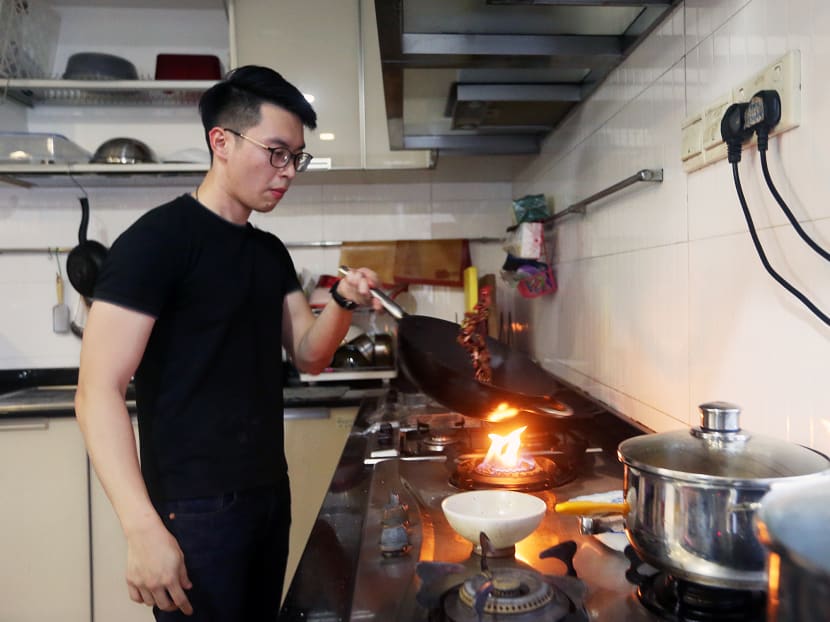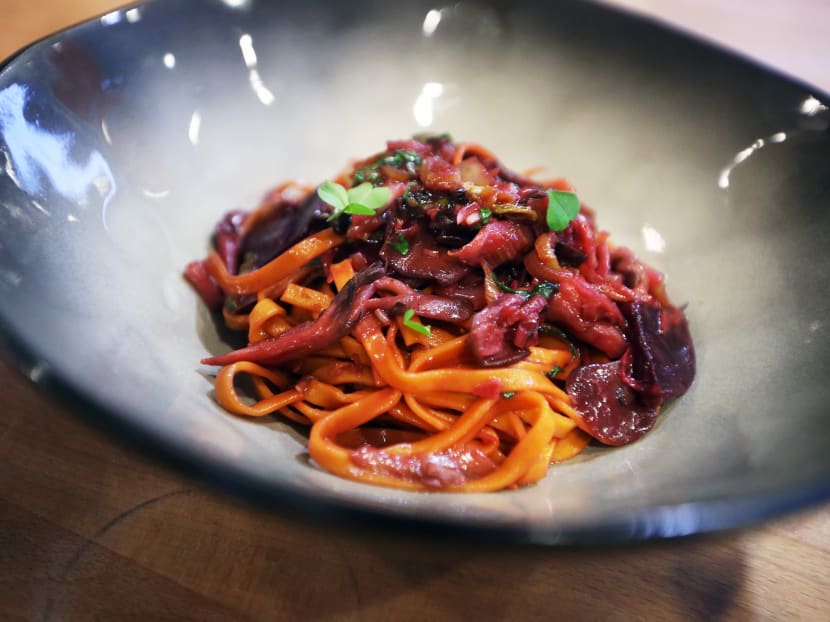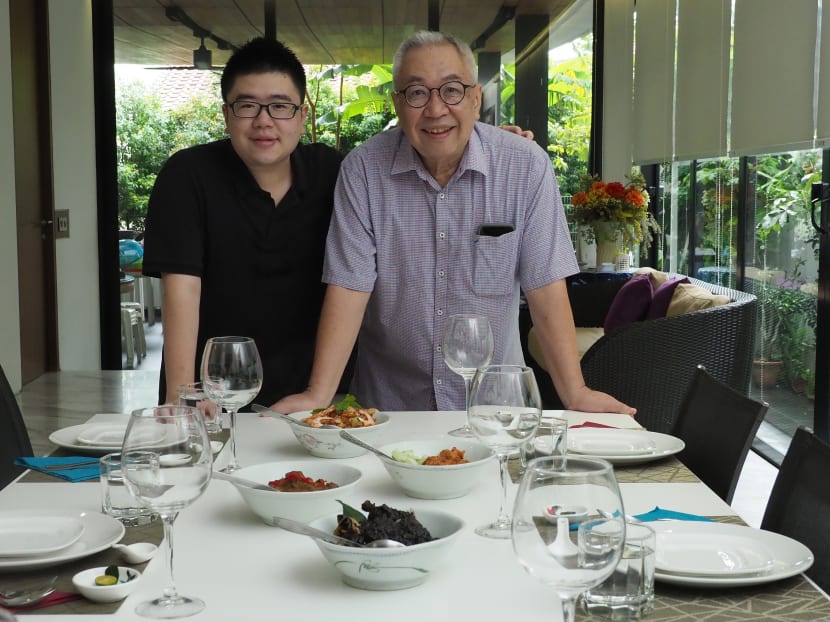‘You feel like your mum is cooking’: The trend towards private home dining
SINGAPORE — Mr Yeo Kai Siang serves up Neo-French cuisine, with set meals priced from S$78 to S$138 — what one would expect to fork out at a lavish fine-dining establishment in town. The catch? He is serving customers in his home near Joo Chiat.

Mr Yeo Kai Siang is a part-time private home chef who serves Neo-French cuisine. He started his establishment, Chez Kai, in February last year.
SINGAPORE — Mr Yeo Kai Siang serves up Neo-French cuisine, with set meals priced from S$78 to S$138 — what one would expect to fork out at a lavish fine-dining establishment in town. The catch? He is serving customers in his home near Joo Chiat.
The 27-year-old part-time private home chef calls his establishment Chez Kai (chez is French for “at the home of”), and it is booked one month in advance. His kitchen is his home office, where he painstakingly creates every course from scratch — from rolling his own pasta to baking his own bread.
Working alone, he can serve a maximum of 16 customers a night at the landed property, and has served as many as 40 people over a weekend.
But business has not always been bustling.
When Mr Yeo started out in February last year, he had an average of one reservation every fortnight, with most customers knowing about his business through word of mouth. It took about five months before weekly reservations began to stream in. Nowadays, he no longer has a weekend free.
“It’s basically a seven-day work week,” said Mr Yeo, who works the weekdays in his full-time job at a food procurement firm.
Private home dining seems to be in vogue these days, with three chefs whom TODAY spoke to saying they have seen a significant increase in customers over the past year. One chef said at his peak, he was booked eight months in advance.
Customers at these home businesses said that the combination of the “homely” feeling these establishments boast and the quality of the dishes kept them coming back for more.

A RISING TREND
Mr Raymond Leong, the owner of home dining business The Ampang Kitchen, said that when he first started serving Peranakan cuisine in 2017, there were only four or five establishments similar to his, and that the concept of home dining was “exclusively Peranakan”.
Now, there are too many to count. The 73-year-old has seen new home dining establishments feature diverse cuisines such as Italian and Japanese fusion.
Besides greater variety in cuisine, the establishments are not confined to landed properties with large dining spaces; some are in Housing and Development Board (HDB) flats.
What these establishments have in common are higher-end prices — The Ampang Kitchen has six- to nine-course meals ranging from S$60 to S$100. Italian home dining business Ben Fatto 95 has set meals priced at S$120 and Nonya Bong has three different set meals priced from S$60 to S$100.

Mr Jeffrey Chia, the 70-year-old owner of Nonya Bong, said that it took him nine months since opening in January 2018 to break even, and in that time the business was “very quiet”. To get a booking at his joint now, the earliest slot is in April.
As he does not advertise his services, he believes that “foodie groups” on messaging platforms such as WhatsApp have been partly responsible for spreading the word.
Ben Fatto 95’s owner, Mr Lee Yum Hwa, said that his business operated at 50 to 75 per cent capacity in the first two to three months since it opened in Oct 2018.
But when his homemade pasta began to make a name for itself, the reservations skyrocketed, resulting in a waiting list eight months long. This prompted him to limit bookings to only two to three months in advance.
Mr Lee, 37, said that the rising trend of private home dining can be attributed to the “novelty” that a fine dining experience provides, and many Singaporeans are happy to “give it a shot”.
“It’s also a private space and everyone likes the intimacy,” he said.
Agreeing, Mr Leong said that the prices that his business offers are reasonable compared to other high-end options.
“There are no extraneous costs like corkage… No service charge and GST,” he said. “It’s still fairly good value compared to dining at a restaurant.”
In response to queries from TODAY, the Urban Redevelopment Authority (URA) and HDB said in a joint reply that private home dining businesses are allowed in private and HDB residential premises, under URA’s Small Business Guidelines and HDB’s Home Based Small Scale Business Scheme respectively.
Under these guidelines, home owners have to “ensure that their premises remain primarily for residential use at all times, and are not converted to commercial outlets, or in this case, full-fledged restaurants”.
Owners also cannot display advertisements and business signboards outside the residential unit or pay for advertising, nor employ workers from outside the household. They should also keep the sessions small so that neighbours are not inconvenienced or disturbed.
Lastly, these businesses should adhere to Singapore Food Agencies’ guidelines on good food hygiene practices.
‘FEEL LIKE YOUR MUM IS COOKING’
Despite the steep pricing and lack of regulation, customers said the privacy and high culinary standards make the home dining experience worth it.
Ms Jessie Goh, who has been to Nonya Bong on three occasions over the last year, said: “(Home dining) is not like a restaurant with a private dining room. In a restaurant you still feel like you’re with many other people.”
Besides being served food she believed was on par with fine dining restaurants, the ability to freely “laugh, interact with friends and catch up over a meal” was what made the experience special, said the 45-year old who works in a polytechnic.
Ms Jenny Lee, who dined early last year at Cantonese private dining establishment Lucky House, said the idea of home-cooked food was what attracted her family to go despite having to fork out S$100 per head.
“We can actually go to (the chef’s) kitchen and see what he was doing. When he served the soup, he will explain to you how he does the food, how long he took to boil the soup,” said the 55-year-old personal assistant.
“You feel like your mum is cooking it. When you’re in a restaurant it’s completely different because it feels more like a business setting.”
ARE THESE BUSINESSES VIABLE?
The private home dining chefs believe theirs is a viable business model.
“Why there is a sudden boom is because chefs are starting to realise the costs of operating (a private dining establishment) is a lot lower than you might imagine,” said Mr Yeo from Chez Kai.
“Your manpower and rent are the most crippling factors … Which is why most restaurants take two to three years to break even,” he added.
By working only two days and serving about 15 people a week, Mr Yeo said he can easily rack up about S$2,000 a month in profit.
Some home dining chefs also enjoy the freedom of working alone, as well as the ability to control the menu — things they cannot do when working at a restaurant.
Though preparing Peranakan dishes such as ayam buah keluak and beef rendang is tedious and time-consuming, Mr Leong prefers doing it in his own time, without the pressure of a kitchen full of chefs.
He whips up the dishes with his son David, who at 28 hopes to eventually take over the business. “It’s easy working with one person,” said the elder Mr Leong. “I don’t want David to be a slave to a business. We have to enjoy our lives and work.”
Mr Yeo, on the other hand, enjoys the freedom he has in inventing new dishes.
“I like the creative aspect of it,” he said. “Trying out new flavour combinations, and realising the dish.”

F&B consultant Derrick Chew believes that these businesses can appeal to tourists as well.
“Singapore is a mishmash and melting pot of all the cuisines,” he said. “To go into the homes and experience the culture behind the cuisine, that’s a unique selling point.”








